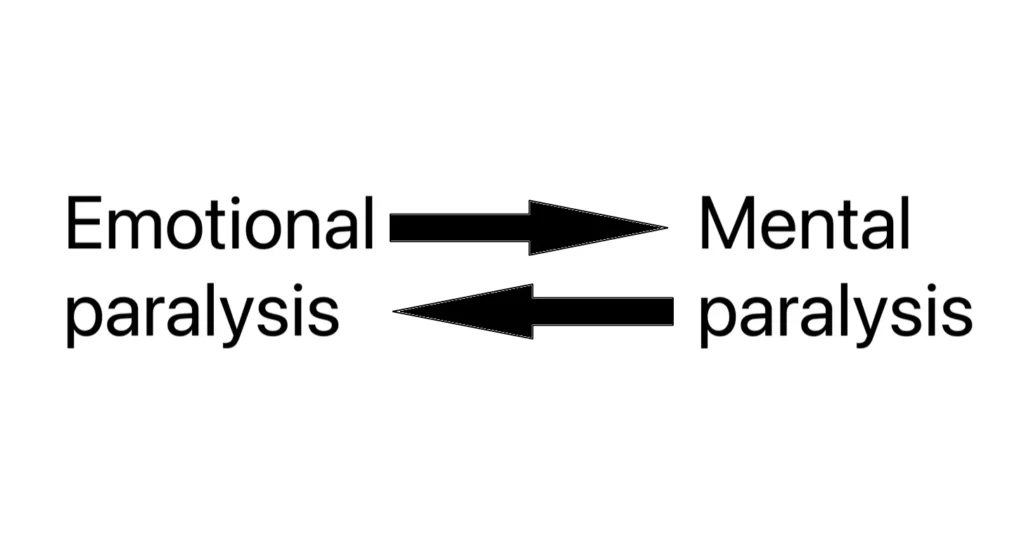You may already be familiar with the ‘freeze response’ to stress. Usually, the normal stress response is the fight-or-flight response. If you can fight with the source of your threat/stress, you’ll fight. If you can’t, you’ll try to escape (flight). These are basic survival responses present in all animals.
The freeze response occurs when you can’t choose between fight or flight. You perceive the threat, but you can’t do anything about it. So your body freezes. It could be a way to avoid detection by predators, but it also allows you to monitor the source of your threat and buys you time to make the right decision.
The interesting part here is that the freeze response may not just be about your behavior. It can also be about your emotions and mind (thinking). That means, when you experience the response, not only does your body get paralyzed, but you may also experience mental or emotional paralysis (EP).
Emotional vs mental paralysis
EP is the inability to experience emotions. Your emotions come to a halt. You can’t feel them. You can’t sense them moving inside you.
Mental paralysis is when your mind stops or, as is commonly heard, ‘goes blank’. You can’t think or are unable to think clearly. There’s a bi-directional relationship between mental/psychic and EP, meaning that one may lead to the other.1Krystal, H., & Krystal, J. H. (2015). Trauma and affect. In Integration and Self Healing (pp. 137-169). Routledge. But both can also occur independently.

What causes EP?
Overwhelming stress
Why do our emotions shut down in the face of stress during the freeze response?
When you experience intense negative emotions like fear, anxiety, depression, shame, etc., your emotional system gets overloaded. Your mind has a limited emotional bandwidth. When that bandwidth gets overloaded by intense negative emotions, the mind shuts down emotional processing. It has run out of its emotional resources to process further emotions.
This emotional shutdown can be seen as the mind’s way of protecting you from emotional pain. Say you’re feeling intense emotional pain in a threatening situation and can do nothing about it. In that case, it’s better to blunt your ability to feel pain so you can tolerate more pain without being aware of it. Thus, EP has also been called:
- Emotional numbing
- Emotional blunting
- Emotional anesthesia
It’s the same phenomenon as when your body experiences stress or pain (as in exercise), and then you feel good because endorphins get released. This pain-killer effect of endorphins not only applies to the body and physical pain but also to the brain and emotional pain.2Burback, L., Forner, C., Winkler, O. K., Al-Shamali, H. F., Ayoub, Y., Paquet, J., & Verghese, M. (2024). Survival, attachment, and healing: an evolutionary lens on interventions for trauma-related dissociation. Psychology research and behavior management, 2403-2431.
The indirect effect of stress
Stress can induce emotional blunting directly or indirectly. Directly when it’s overwhelming and accompanied by intense negative emotions. Indirectly via mental paralysis, even when it’s mild. Even mild, everyday stress can shut down the prefrontal cortex (PFC) region of the brain.3Arnsten, A., Mazure, C., & Sinha, R. (2012). Everyday stress can shut down the brain’s chief command center. Scientific American, 306(4), 48-53.
When the PFC shuts down (mental paralysis), it can no longer regulate negative emotions, which is one of its essential functions. When that function gets impaired, even initially moderate negative emotions can uncontrollably spiral into overwhelming emotions, leading to emotional shutdown.
You can also experience EP by 'catching' the overwhelming emotions of others. An inability to handle your own intense emotions leads to an inability to handle others' intense emotions.
Trauma
Situational EP occurs when you experience overwhelming stress in the present. If the situation gets resolved, the EP goes away. The quality of being unresolved is inherent to trauma. So, it makes sense that trauma-induced EP should be sustained, not just situational.
EP in response to a traumatic experience is induced by a phenomenon called dissociation. Dissociation means disconnection. The term is often used in the context of cognitive dissociation. That means mentally disconnecting from a situation. It can manifest as zoning out, daydreaming, and, in severe cases, as ‘feeling like you left your body’ or even dissociative identity disorder (multiple personality disorder).
Related: 5 Types of Dissociation
Dissociation can also be emotional, meaning you feel emotionally disconnected from a situation. Thus, dissociation can, and does, induce emotional numbing.4Shin, G. I., Goldstein, L. H., & Pick, S. (2019). Evidence for subjective emotional numbing following induced acute dissociation. Behaviour Research and Therapy, 119, 103407. Trauma-related, dissociation-induced emotional numbing is linked to anxiety disorders, depression, and PTSD.5Litz, B. T., Litz, B. T., & Gray, M. J. (2002). Emotional numbing in posttraumatic stress disorder: Current and future research directions. Australian & New Zealand Journal of Psychiatry, 36(2), 198-204. This is why those who’ve gone through traumatic experiences talk about ‘feeling numb’ most of the time. They feel a disconnect between themselves and their emotions.
Encountering your trauma triggers, especially, is highly likely to induce emotional numbing.6Schauer, M., & Elbert, T. (2015). Dissociation following traumatic stress. Zeitschrift für Psychologie/Journal of Psychology. It becomes a learned response to the unique situation you faced and its cues.
Impact
If you can’t feel your emotions, you’ll have trouble expressing them. A big part of connecting with others is connecting with them emotionally. A big part of connecting emotionally with others is expressing your emotions. This inability to feel emotions can thus negatively impact all your relationships. Poor relationships not only lead to social stress (more stress, more problems) but also hinder your ability to reach your important goals.
Examples
Tim was abused in early childhood by his father. His mind induced sustained EP that he carried over into school. He remained aloof in class and didn’t open up to anyone. He still struggles with making friends in adulthood.
Jim went through a significant breakup. The event was traumatizing, and he suffered from PTSD-like symptoms. He felt emotionally numb soon after the breakup. For a long time, he thought he had lost the ability to love, trust, and care because he no longer felt those emotions.
Coping
The best way to overcome emotional shutdown is to eliminate the overwhelming stress from your life that’s causing it. Take inventory of all your stressors and work on eliminating the major ones. Usually, these will be big problems that you’re facing but haven’t solved, or you’re avoiding even facing.
You may not have the resources (knowledge and skills) to solve these problems. In that case, you can start by becoming more resourceful, educating yourself, and seeking help.
While you work on resolving the major emotional problems of your life, you can work on stress management. Techniques like journaling and grounding can help. When you write about what you’re feeling in a journal, you force your emotions out and work with them. This gets them moving.
Grounding involves becoming aware of your small sensations and feelings. By focusing on the objects you see (their color, shape, and size), sounds you hear, and the textures you touch, you bring your mind back into your body. This reduces the disconnect between your body and mind.
Since emotions drive actions, emotional numbing often goes hand in hand with behavioral paralysis. Emotionally numb people show inhibited behavior because they feel no emotions to drive their behavior. When you overcome EP, it will be reflected in your behavior. You’ll move, emotionally as well as physically.

